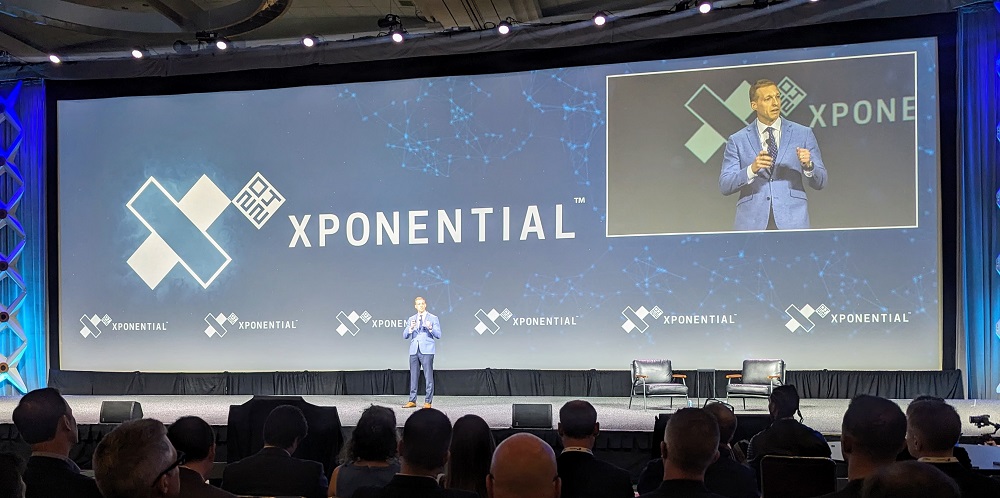For years now, AUVSI's XPONENTIAL has been an event that pulls the drone community together to explore everything from what it means for the technology to be an agent of disruption to how it can provide a framework for cybersecurity. These same themes were present at XPONENTIAL 2024, but they’ve expanded and evolved on multiple levels.
Michael Robbins was recently announced as the association’s new President and CEO, and he kicked off the event with an update around his work to get things moving faster for AUVSI and with the industry as a whole. He mentioned how important it is for the industry to speak with a unified voice in order to move things forward, but also outlined where his priorities are in the short and long term.
"I prioritize movement over motion,” Robbins told the crowd. “We're shaping the future with BVLOS rulemaking to open up high-value applications like drone delivery and inspections while also laying the groundwork for Part 108.”
Much has been made of AUVSI’s stance on their approach to leveling the playing field for American-made drone companies, and he assured the crowd they have heard this feedback. He mentioned that AUVSI will only support common sense solutions to diversify the supply lines outside of China.
In 2023, cybersecurity issues were framed in the context of the war in Ukraine but in 2024, keynote speakers talked about how these issues are being resolved in both commercial and defense applications. Connections between the two outlined what it means for these innovations to make a difference in both sectors.
“We recognized that we have to harness the power of the commercial market rather than just approach it from the defense side,” said Doug Beck, Director of the Defense Innovation Unit (DIU) and Senior Advisor to the Secretary of Defense. “We have to harness it all together.”
Those insights were connected to the announcement that AUVSI has entered into a Memorandum of Understanding (MOU) with the Defense Innovation Unit (DIU). The MOU creates a process for drone component manufacturers holding Green UAS certification to share their data directly with DIU, with an aim to potentially include Green certified components on DIU’s Blue UAS Framework list.
Additionally, the event saw the launch of Skapa by Saab. In Swedish, Skapa means “to create, to make, to shape,” highlighting how the product is designed not be dynamic. Michael Brasseur, Chief Strategy Officer at Saab Inc., mentioned the goal with the solution is to ensure collective security.
 Such larger opportunities were further explored on the Wednesday keynote, which featured multiple FAA representatives in a candid conversation about what it means for the industry to go from idea to integration. Moderated by Matt McCardle, Head of Global Regulatory Affairs and Strategy at Amazon Prime Air, the panelists outlined their approach to integrating drones into the airspace, with the key focuses being around data and safety.
Such larger opportunities were further explored on the Wednesday keynote, which featured multiple FAA representatives in a candid conversation about what it means for the industry to go from idea to integration. Moderated by Matt McCardle, Head of Global Regulatory Affairs and Strategy at Amazon Prime Air, the panelists outlined their approach to integrating drones into the airspace, with the key focuses being around data and safety.
“We want the money and time you invest to actually see the light of day,” said Marc Nichols, Chief Counsel at the FAA. “We want to make sure anything you’re doing will be able to withstand judicial scrutiny. So that down the line, there’s not a panel that says, ‘you didn't do it right.’”
Tim Arel, Chief Operating Officer, Air Traffic Organization at the FAA, mentioned that the agency is looking to partner with the industry so that the FAA can adjust their culture while remaining technology agnostic. He said they want to work with stakeholders and the technology in a different way.
McCardle expressed how necessary that approach is, since on the industry side, it can be frustrating to understand where things are in the process. So, what goes on behind the scenes?
“You have to realize that the FAA is made up of over 45,000 people, not all of whom are based in the United States,” said Laurence Wildgoose, Assistant Administrator for Policy, International Affairs, and Environment at the FAA. “Communication takes time, and we need to understand how each piece could be impacted.”
That impact is being understood through data, and Wildgoose mentioned the FAA needs data to help them do their jobs better. FAA Administrator Michael Whitaker has talked about his focus on gathering and using data, which the panel further highlighted. That information is what they want to use to make that transition from idea to integration, but it’s a process that both sides consider differently.
“What you want is what we want,” Nichols said. “We might not want to get there in the same way, but we also don't want to be the department of ‘no.’ Our job is to see how we can be collaborative and clarify the thinking.”
What does it mean for industry advocates to support that endeavor though? How can industry be part of the solution?
Arel mentioned that the best thing to do is to come to the FAA early. Find out what's happening right now in the environment and go to the FAA with data ready to support what it means to be compatible and integrate into the system. Data drives all of their decisions, which means they want to hear about what it means to mitigate potential risk.
Mitigating risk is something that Hal Brands spoke to on a global level. Brands is a scholar at the American Enterprise Institute and provided the audience with an update on how drone technology is making a difference on every side of the conflict in Ukraine and across the Middle East. These developments aren’t limited to these regions though, and they’re already expanding beyond them.
“Uncrewed systems have drastically reduced the price to exert power and influence," Brands said. "Bursts of innovation also bring bursts of counter-innovation.”
Those innovations and counter-innovations highlight the quantifiable movement of individual pieces of drone technology as well as shifts forward for the entire industry.
















Comments